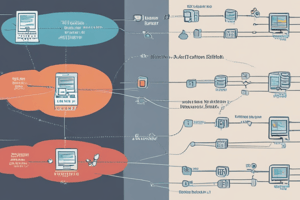Podcast
Questions and Answers
What is the primary purpose of the OSI model in networking?
What is the primary purpose of the OSI model in networking?
- To establish standard protocols for video communications
- To define a layered networking framework for implementing protocols (correct)
- To enhance the speed of data transmission over networks
- To provide a physical connection between devices
Which layer of the OSI model is responsible for the actual transmission of digital data bits?
Which layer of the OSI model is responsible for the actual transmission of digital data bits?
- Application Layer
- Transport Layer
- Physical Layer (correct)
- Network Layer
How does learning the OSI model facilitate communication with technical colleagues?
How does learning the OSI model facilitate communication with technical colleagues?
- It establishes standardized communication protocols
- It eliminates the need for technical jargon
- It allows for better personal interactions
- It simplifies the understanding of overall network operations (correct)
Which of the following technologies operates at Layer 1 of the OSI model?
Which of the following technologies operates at Layer 1 of the OSI model?
What does the OSI model help us understand about network requests?
What does the OSI model help us understand about network requests?
Which of the following is NOT a benefit of learning the OSI model?
Which of the following is NOT a benefit of learning the OSI model?
Which layer of the OSI model deals primarily with routing data across networks?
Which layer of the OSI model deals primarily with routing data across networks?
The OSI model is mainly utilized today as a:
The OSI model is mainly utilized today as a:
What is the primary function of the Presentation Layer in the OSI model?
What is the primary function of the Presentation Layer in the OSI model?
Which layer directly supports the Application layer in the OSI model?
Which layer directly supports the Application layer in the OSI model?
In the context of OSI model layers, what does the Application Layer use to package data for web content?
In the context of OSI model layers, what does the Application Layer use to package data for web content?
Which of the following best describes an example activity of the Application Layer?
Which of the following best describes an example activity of the Application Layer?
What role does a Web browser play in the Application Layer?
What role does a Web browser play in the Application Layer?
Which of the following is NOT a function of the Presentation Layer?
Which of the following is NOT a function of the Presentation Layer?
How does the Presentation Layer support the Application Layer?
How does the Presentation Layer support the Application Layer?
Which layer is responsible for the syntax used in message data?
Which layer is responsible for the syntax used in message data?
What is the role of ARP when a computer wants to reach a Web server?
What is the role of ARP when a computer wants to reach a Web server?
Which layer is responsible for inserting the Web request inside a network request to the default gateway?
Which layer is responsible for inserting the Web request inside a network request to the default gateway?
How does a computer determine the path to a Web server on the Internet?
How does a computer determine the path to a Web server on the Internet?
What does the physical layer provide in the process of sending a Web page request?
What does the physical layer provide in the process of sending a Web page request?
What is the purpose of the default gateway in networking?
What is the purpose of the default gateway in networking?
What primary function does the Data Link layer perform when obtaining data from the Physical layer?
What primary function does the Data Link layer perform when obtaining data from the Physical layer?
Which sublayers comprise the Data Link layer?
Which sublayers comprise the Data Link layer?
What is the primary responsibility of the Network layer?
What is the primary responsibility of the Network layer?
In which layer of the OSI model would you primarily find TCP used for data transport?
In which layer of the OSI model would you primarily find TCP used for data transport?
What does the Address Resolution Protocol (ARP) do in IP networking?
What does the Address Resolution Protocol (ARP) do in IP networking?
Which layer is responsible for managing the flow of events that initiate and tear down network connections?
Which layer is responsible for managing the flow of events that initiate and tear down network connections?
What type of signaling is used at the Physical layer for data transmission?
What type of signaling is used at the Physical layer for data transmission?
What is one of the capabilities that the Transport layer may support?
What is one of the capabilities that the Transport layer may support?
What is the primary role of the PRESENTATION layer?
What is the primary role of the PRESENTATION layer?
What happens when a Web browser requests a Web page?
What happens when a Web browser requests a Web page?
How does a Web browser handle additional resources such as images or style sheets?
How does a Web browser handle additional resources such as images or style sheets?
What is the function of the TCP connection in web communications?
What is the function of the TCP connection in web communications?
Which protocol is responsible for providing unique addresses for the Web server and computer?
Which protocol is responsible for providing unique addresses for the Web server and computer?
What is created whenever a Web browser communicates with a Web server?
What is created whenever a Web browser communicates with a Web server?
Which layer deals directly with the transport of data across the correct SESSION?
Which layer deals directly with the transport of data across the correct SESSION?
Which of the following describes how a web browser converts file formats?
Which of the following describes how a web browser converts file formats?
Flashcards
OSI Model
OSI Model
A networking framework that divides computer network architecture into 7 logical layers for implementing protocols.
Physical Layer
Physical Layer
The lowest layer of the OSI model, responsible for the transmission of digital bits over network media
Networking Framework
Networking Framework
A structure or blueprint that allows devices to communicate across a network, using layered protocols, and with controls passed from one layer to another.
Network Architecture
Network Architecture
Signup and view all the flashcards
Layered Design
Layered Design
Signup and view all the flashcards
Troubleshooting
Troubleshooting
Signup and view all the flashcards
Computer Problems
Computer Problems
Signup and view all the flashcards
Data Communication
Data Communication
Signup and view all the flashcards
Physical Layer Function
Physical Layer Function
Signup and view all the flashcards
Data Link Layer Role
Data Link Layer Role
Signup and view all the flashcards
Network Layer Functionality
Network Layer Functionality
Signup and view all the flashcards
Transport Layer Protocols
Transport Layer Protocols
Signup and view all the flashcards
Session Layer Management
Session Layer Management
Signup and view all the flashcards
Network Addresses
Network Addresses
Signup and view all the flashcards
Data Packets
Data Packets
Signup and view all the flashcards
Media Access Control
Media Access Control
Signup and view all the flashcards
Presentation Layer Function
Presentation Layer Function
Signup and view all the flashcards
Application Layer Role
Application Layer Role
Signup and view all the flashcards
HTTP Protocol (Application)
HTTP Protocol (Application)
Signup and view all the flashcards
Web Browser Application
Web Browser Application
Signup and view all the flashcards
Web Page Display
Web Page Display
Signup and view all the flashcards
Application Layer interaction with Presentation Layer
Application Layer interaction with Presentation Layer
Signup and view all the flashcards
OSI Model Layer 6
OSI Model Layer 6
Signup and view all the flashcards
OSI Model Layer 7
OSI Model Layer 7
Signup and view all the flashcards
IP Protocol
IP Protocol
Signup and view all the flashcards
ARP Protocol
ARP Protocol
Signup and view all the flashcards
Default Gateway
Default Gateway
Signup and view all the flashcards
MAC Address
MAC Address
Signup and view all the flashcards
Data Link Layer
Data Link Layer
Signup and view all the flashcards
Presentation Layer
Presentation Layer
Signup and view all the flashcards
HTTP
HTTP
Signup and view all the flashcards
Session Layer
Session Layer
Signup and view all the flashcards
TCP Connection
TCP Connection
Signup and view all the flashcards
Transport Layer
Transport Layer
Signup and view all the flashcards
Network Layer
Network Layer
Signup and view all the flashcards
Internet Protocol (IP)
Internet Protocol (IP)
Signup and view all the flashcards
Web Page Instructions
Web Page Instructions
Signup and view all the flashcards
Study Notes
Why Should We Learn the OSI Model?
- Learning the OSI model helps understand functions, timing and where they occur.
- It helps understand how a web browser works.
- It explains how Internet Protocol works.
- Shows why ARP and MAC addresses are necessary.
- Makes learning and troubleshooting easier, including computer problems.
- Facilitates communication with technical people and discussing technical issues.
OSI Model Layers
- The OSI model defines a networking framework with 7 layers: Application, Presentation, Session, Transport, Network, Data Link, and Physical.
- Each layer builds upon the previous one, with control passing from one to the next.
- The layers are primarily used as a teaching tool.
- Lower layers handle electrical signals, data chunks, and routing.
- Higher layers address requests and responses using network protocols.
Physical Layer
- Layer 1 is responsible for transmitting digital data bits from the source to the destination.
- Technologies like Ethernet and Token Ring are examples.
- Includes hubs, repeaters, and cable connectors.
- Data transmission uses signaling types such as electric voltages, radio frequencies, and light pulses.
Data Link Layer
- Layer 2 checks for transmission errors, packaging bits into frames.
- Manages physical addressing schemes (e.g., MAC addresses for Ethernet).
- Controls device access to the physical medium.
- Often divided into Media Access Control and Logical Link Control sublayers.
Network Layer
- Layer 3 adds routing functionality, focusing on source and destination addresses.
- Formats data into packets, delivered to the Transport layer.
- Uses logical addresses (e.g., IP addresses) for devices on the network.
- Manages the mapping between logical and physical addresses (e.g., using ARP).
Transport Layer
- Layer 4 delivers data across network connections.
- TCP is a common example of a transport protocol.
- Protocols can support error recovery, flow control, and re-transmission capabilities.
Session Layer
- Layer 5 manages network connection initiation and termination.
- Supports multiple connection types that can be created dynamically.
Presentation Layer
- Layer 6 handles message syntax processing: format conversions, encryption, and decryption.
Application Layer
- Layer 7 provides network services to user applications (e.g., web browsers).
- Examples include protocols like HTTP for web browsing.
OSI Model Operational Example (using Ethernet card)
- Applications like web browsers initiate requests.
- Requests are converted to messages and sent to the network card.
- The card passes them to the network layer for routing.
- The network layer then checks addresses to determine the final destination.
- Layer 1 (Physical) transmits the request.
Studying That Suits You
Use AI to generate personalized quizzes and flashcards to suit your learning preferences.



